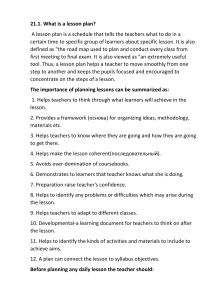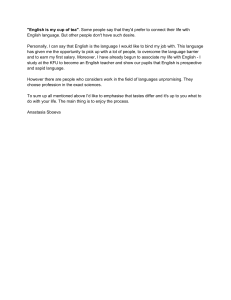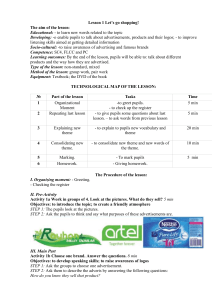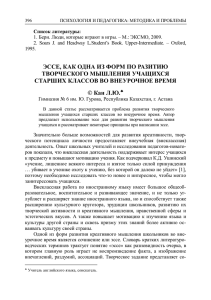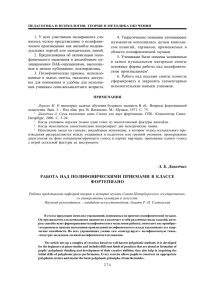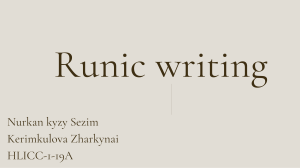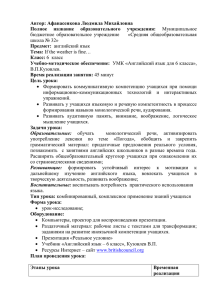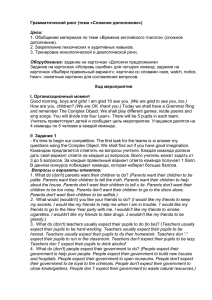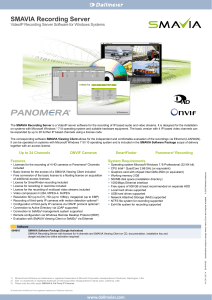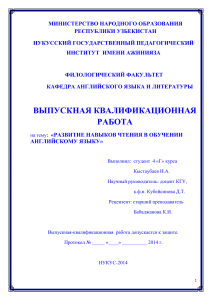Государственное общеобразовательное учреждение средняя общеобразовательная школа № 593
реклама
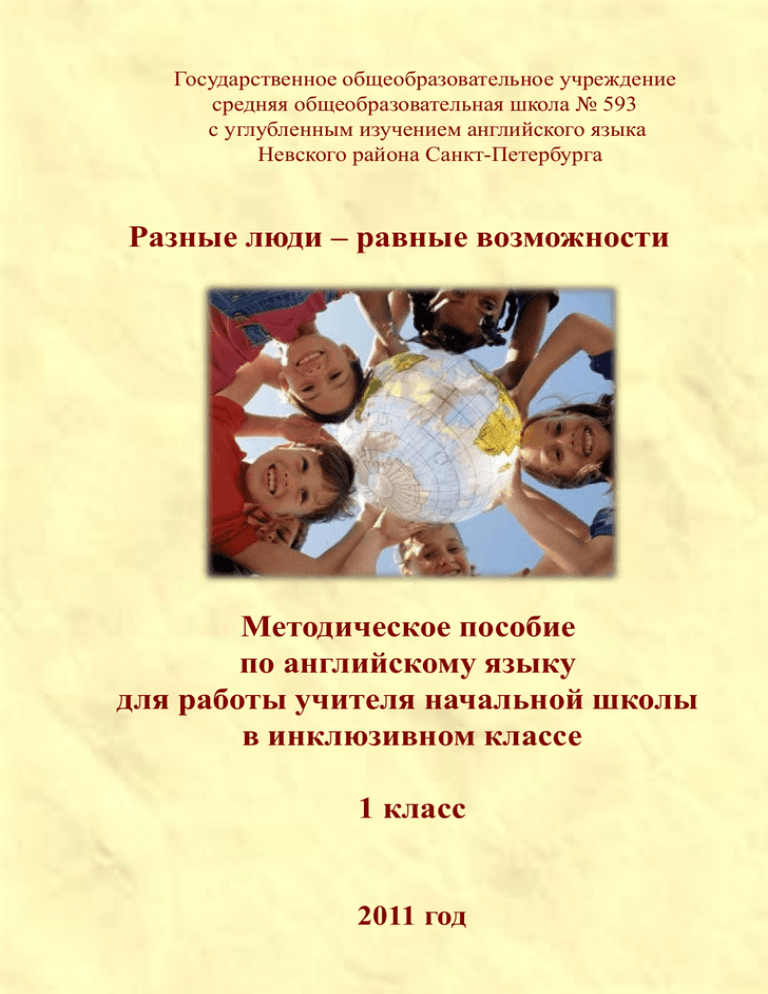
Государственное общеобразовательное учреждение средняя общеобразовательная школа № 593 с углубленным изучением английского языка Невского района Санкт-Петербурга Разные люди – равные возможности Методическое пособие по английскому языку для работы учителя начальной школы в инклюзивном классе 1 класс 2011 год Государственное общеобразовательное учреждение средняя общеобразовательная школа № 593 с углубленным изучением английского языка Невского района Санкт-Петербурга Разные люди – равные возможности Методическое пособие по английскому языку для работы учителя начальной школы в инклюзивном классе 1 класс 2011 год В данном издании представлены уроки по английскому языку для работы учителя начальной школы в инклюзивном классе. Издание первое. В методическом пособии даются разработки нескольких уроков по английскому языку в 1-ом классе, где совместно обучаются учащиеся с ограниченными возможностями здоровья с сохранным интеллектом и дети, не имеющие таких ограничений. Эти уроки выбраны не случайно из программы обучения по английскому языку в 1-ом классе, так как на этих занятиях удачно использован дифференцированный подход в обучении с детьми, имеющими разные возможности. Каждый урок имеет целевую установку. Учитель точно определяет разные задачи, работает над различными проблемами по следующему алгоритму: -Какие знания, умения и навыки важно получить детям на уроке. -Что помогает учителю более успешно работать с учащимися, имеющими разные возможности. - Как сделать усвоение материала более эффективным. - Результативность урока. 2 Уважаемые коллеги! Пособие, которое вы держите в руках, создано для того, чтобы помочь вам и всем нам принимать мир таким, какой он есть. А мир очень многообразен и удивителен. Прежде всего, он интересен своими людьми. Каждый человек уникален, и нет в мире похожих друг на друга людей. Очень важно, как человек относится к себе. Но ещё важнее то, как мы относимся к другим людям, которые, например, непохожи на нас. Почему же, проходя по улице и видя непохожих на нас людей, мы относимся к ним иначе. Чаще всего мы стараемся стыдливо отвести от них глаза, у кого-то больно щемит сердце при виде таких людей. Наступил такой момент, когда мы, педагоги, должны понять, что человеческая жалость должна быть заменена добротой учителя, умением работать с разными людьми и особенно детьми. Они имеют право быть равными со всеми. Мы предлагаем свою модель урока в инклюзивном классе.Возможно, вы добьетесь высоких результатов, пойдете дальше в этой работе. Мы с удовольствием будем у вас этому учиться! В одном мы убеждены точно: «Разные люди имеют равные возможности! Дети могут учиться вместе!» 3 4 Unit 1 Module objectives: 1. Handwriting and listening practice. 2. Teaching and learning the sounds and names of the alphabet. 3. Creating friendly atmosphere. Resources used: Cassette, classroom objects, e.g. pets, books, pencils. Unit 1 Lesson 1 PB:A,B The topic: car racing. Teaching points: 1. Learn the colours. 2. Learn the alphabet. PB1:A • Learn the letter A, sound [ei]. • Look at picture 1 and say “Hello!”. Ask one pupil to say “Hello” to another pupil. Practise this around the class with the doll. Say “well done” frequently for encouragement. • Point to the word and colour red and say “red”. Prompt pupils to repeat this. Do the same for yellow, green and blue. Then the pupils listen to the recording. Pupils repeat the words one by one after the recording. Practise the chant with the children clapping out the rhythm. PB 1: C Say “Hello” to the class then to the individual pupils. Show 4 balls – red, yellow, green and blue and repeat the colours. Show the words and repeat together with the pupils. Look at activity C on page 3 and trace over the words printed in grey. 5 Unit 1 Lesson 2 PB 1:C, 1:D Teaching points: 1. Use new lexics. 2. Develop the writing skills. The task: Disabled children Tick the colour written next to the racing cars The group Colour the pictures according to the colour written next to the racing cars. Some children have problems. Ask them to look at 2 A again and compare the words. 6 PB1:E Teaching points: 1. Learn the alphabet. 2. Learn and use new lexics. 3. Develop listening skills. • Say “Hello” to the class then to the individual pupils. Show Kit and Mel puppets and learn the words cat – mouse. The children listen and look at the pictures, then listen again and repeat. Children act out the play with one pupil using the Mel puppet and the other the Kit puppet. Unit 1 Lesson 3 PB1:F Teaching points: 1. Learn new lexics. 2. Develop writing skills. 3. Develop reading skills. 4. Learn the alphabet. Say “Hello” to pupils and individual pupils and elicit «Hello» from the children. Repeat the colours, show the cards of different colours, read them aloud with the pupils. Read the words next to the sun, ask individual pupils to repeat them. Disabled children The task F, G Trace the words according to the picture. The group Trace the words printed in grey. Possible problems: Some students have remembered what they have learned previously and which students have forgotten some of what they have learned. Individual students need extra practiсe in their weaker areas in class. 7 Results: Pupils have learned the colours and to answer yes/no questions. Unit 2 Unit 2 Lesson 1 Module objectives: 1.Learn and use new lexics. 2.Learn the alphabet. 3.Develop writing and listening skills. 4.Practise in asking questions. PB 2:A, 2:B p.6; p. 50-51 1. Learn the alphabet. 2. Use new lexiсs. Revision Materials: colour flashcards. P 1: (holds up a flashcard) : Red? Cl.: Yes / No ( show flashcards). PB 2:A p.6. • Listen to the alphabet song. • Look at the Letter Gonk and point to the letters and words at p.6 • Introduction of the letters and sounds ( Teacher writes on the board): a - makes the sound [ æ] b - makes the soud [ b ] c - makes the sound [c] • Listen to the recording and repeat the sounds. • Repeat the sounds of the letters and the words with the class and individual pupils without the recording. 8 Difficulties: • Repeat the sounds with individual pupils without the recording. • Listen to the teacher (the teacher pronounces the chant slowly). • Repeat the chant slowly after the teacher. • Listen to the chant again and join in with the children on the recording. Handwriting practice (p.50) • Trace over the grey letters for the letters a, b, c. Difficulties Disabled pupils do this kind of work with the help of the teacher. 9 PB 2:B • Look at the pictures and explain how the children win the prizes. Listen to the recording. The teacher asks some questions and discusses the situation with the pupils. T: Where are the children? What are they doing? • Repeat after the recording. • Read on roles in group of five pupils (change roles). • Train the lexiсs with flashcards (T.: - A bike ? Cl.: -Yes / No). Handwriting practice (p.51) • The teacher explains the tasks. • Do exercises for letters a, b, c. Difficulties Disabled pupils do exercises with the help of the teacher. Results Ending the lesson. Unit 2 Lesson 2 PB 2:C ,D, E p.7 The teaching points: 1. Practice reading and listening. 2. Learn the alphabet. 3. Revise the words with the flashcards. PB 2: C, p.7 Teacher writes the words on the board. T. – Cl. (Read the words after the teacher). • Read individually. • Listen to the chant on the recording and clap out the rhythm of the chant. Listen to the recording and join in. 10 PB 2: D • Listen to the recording. • Circle the words you hear. • Listen to the recording and check. PB, 2: E p. 7. The game «Guess!» • Listen and look. • Listen and repeat. • Play games in pairs. Results. Ending the lesson. Children have learned new lexics and the letters A, B, C. Unit 2 Lesson 3 PB 2:F, p.8 Materials: Puppets Mel and Kit. Teaching points: 1. Develop reading skills. 2. Develop speaking skills through roleplays. 3. Learn the alphabet. Classwork Disabled children Act out the seller Kit. The group Act out the scene with their puppets. Revise the words with flashcards. T: A ball? – Cl.: Yes / No. 11 PB 2:F, p. 8. Cartoon time. Look at page 8. T: What type of shop is it? What are your favourite toys and games? • Listen to the recording and look at the picture. • Repeat after the recording. • Act out with the puppets (in pairs). Handwriting practice. Copy a line of a, b, c in your exercise-books. Difficulties: Disabled pupils do this task with the help of the teacher. Results. Ending the lesson. Unit 2 Lesson 4 PB2: G, 2: H p. 9 Materials: a ball, a box, an apple. The teaching points: 1. Practice in asking questions. 2. Learn the alphabet. 3. Develop the writing skills. Teacher shows and offers an apple to the class T: An apple? The teacher says: Yes, please / No, thank you. The pupils listen to the recording. The pupils listen to the teacher and repeat after the teacher slowly. The pupils listen to the recording, repeat after the recording. The children look at the pictures, at the face of the mouse and with the help of the teacher try to guess what the mouse answers. Play in pairs (children have different toys and puppets). 12 PB 2: H p.9. Teacher points at the objects: A box? CL.: Yes / No. Trace lines from objects to words. Trace over the words and circle the correct answer. Classwork Disabled children Children trace over 6 words printed in grey and join with the objects. The group Children trace over the words printed in grey and join with the objects. Difficulties: Disabled pupils do the task with the help of the teacher. Handwriting practice. Capital letters. PB p. 60. Do the tracing of the capital letters A, B, C. Difficulties: Disabled pupils do the task with the help of the teacher. Results. Ending the lesson. The children have learned to answer simple questions. 13 Test № 1 The test covers reading, writing and listening skills. Unit 3 Main teaching points: 1. Handwriting, listening, reading and speaking practice. 2. Learn the alphabet. Unit 3 . Lesson 1. PB: A, PB: B p.10. The teaching points: 1. Learn new lexics. 2. Develop listening skills. 3. Practise asking and answering questions. 4. Learn the alphabet. PB: A p. 10. The alphabet , the letters d, e, f. • Listen to the alphabet song. • Teacher explains the sounds these letters make. • Repeat the sounds after the teacher. • Listen to the chant. • Repeat the chant after the teacher. Difficulties: Disabled pupils repeat individually after the teacher slowly. Repeat the chant after the recording. Handwriting practice : letters d, e, f. PB p. 50-52. PB p. 50. Trace over the grey letters d, e, f. PB 52. Do exercises for letters d, e, f. Difficulties: Disabled pupils do the task with the help of the teacher. 14 PB :B p.10. In the oceanarium. Duscussing the pictures. • Listen to the recording and look at the pictures. • Read after the recording. • Read on roles (in groups of four). • Pupils act out the parts of the characters showing different fishes and making sounds. Results. Ending the lesson. Unit 3. Lesson 2. PB:C , D, E p. 11. The teaching points: 1. Develop speaking and writing skills. 2. Learn the alphabet. Repeat the chant (PB 3:A p. 10). PB: C p. 11. The song. • Listen to the recording and look at the picture. • Repeat after the teacher slowly. Difficulties: Disabled pupils repeat individually after the teacher slowly. Sing the song with the recording. PB: D p. 11. Little / big. • Listen to the recording and look at the picture. • Teacher explains the words little and big. • Play the game in pairs (children try to show a big object and a little object). PB: E p. 11. • Teacher reads the words under the objects. • Repeat after the teacher. • Colour the objects and trace over the words. • Classwork. 15 Disabled children Trace over the words printed in grey under 2 pictures you like best. The group Trace over the words printed in grey and colour the pictures. Difficulties: Disabled pupils do the task with the help of the teacher. Results. Ending the lesson. The children have learned new lexics and the letters E, D, F. Unit 3 . Lesson 3. The teaching points 1. Practice in asking and answering questions. 2. Develop speaking skills through the roleplay. PB: F p. 12. Puppets Mel and Kit. Sing the song «Red, yellow». PB: F. p.12 Cartoon time. • Listen to the recording and look at the picture. • Repeat after the recording. • Repeat after the teacher. 16 Difficulties: Disabled pupils repeat individually after the teacher slowly. Read on roles (in pairs). Act out the parts of Mel and Kit (children have a green apple, a plate, a fish, an egg, a banana and Menu). Handwriting practice. Teacher writes letters d, e, f on the board. Copy a line of d, e, f into your exercise-books. Difficulties: Disabled pupils do the task with the help of the teacher. Results. Ending the lesson. The children have learned to read words. Unit 3. Lesson 4. PB: G, H p. 13. PB p. 60-61. The teaching points: 1. Develop writing and reading skills. Classwork 3: G The teacher shows the pictures and pupils say: “a red apple” “a blue fish”. Trace over the words printed in grey. Join the words with the objects. Disabled children Join the words with the objects and trace over the words to 1 picture you like best. The group Read and join the words with the objects and trace over 10 words printed in grey. PB : G p. 13. Difficulties: Disabled pupils do the task with the help of the teacher. Teacher reads the items. The children name the letter. Play the game in pairs. 17 PB:H p. 13. Identity the picture. Join the letters to the objects. Write over the grey letters. Difficulties: Disabled pupils do the task with the help of the teacher. Handwriting practice. Capital letters D, E, F. PB p. 60-61. Do the tracing of the capital letters D, E, F. Do exercises from A till F on pages 60-61. Difficulties: Disabled pupils do the task with the help of the teacher. Results. Ending the lesson. Unit 4 Main teaching points: 1. Learn the alphabet. 2. Develop writing skills. 3. Develop grammar skills (Plurals and Numbers1-7). Unit 4 Lesson 1 PB: A, B p. 14 Teaching points: 1. Learn the alphabet G, H, I. 2. Learn the numbers 1 – 4. Revision colours with the flashcards. PB: A • Listen to the alphabet song. • Look at the letters and words. • Listen to the recording. • Teacher explains the sounds and helps disabled pupils with pronunciation. Repeat the sounds after the recording. • Listen to the chant and join in. 18 Handwriting practice PB p. 52 Trace over the grey letters g, h, i. Difficulties: Disabled children write letters with the help of the teacher. PB p. 53 Do exercises for the letters g, h, i. Disabled pupils do the task with the help of the teacher. PB: B p.14 Look and discuss the pictures. T: Where are the children now? What are their names? • Listen to the recording and look at the picture. • Learn numbers (1 – 4). • Repeat after the recording and do the actions. • Individual pupils play the teacher and repeat instructions. Results. Ending the lesson. Unit 4 Lesson 2 Teaching points: Revise numbers 1 – 4 and commands up / down. PB : C, D p. 15 Materials: a dice, buttons. Revise commands up – down. PB: C p.15 Revise numbers 1 -4 with flashcards. Disabled children tick the colour of the numbers and join the numbers with the words. The group Colour the numbers and join them with the words. 19 Difficulties: Disabled children do the task with the help of the teacher. PB:D • Disabled children do the task with the help of the teacher. • Play the game in pairs. Handwriting practice Write the numbers 1 – 4 in your exercise books. Difficulties: Disabled children do the task with the help of the teacher. Results. Ending the lesson. The children have repeated the numbers and find colours in the game. Lesson 3 Teaching points: Revise the numbers. Learn new lexics. 20 PB 4: E Look at the pictures. T. Where are Mel and Kit? Why is Kit angry at the end? Listen to the recording. Point to the pictures and repeat the new words. Listen to the teacher and repeat slowly. Listen to the recording again and repeat. Pairs of pupils read the parts of Mel and Kit with puppets. Pupils act out the scene themselves in masks (they have 7 pears). Handwriting practice: Teacher shows the flashcards with letter g , asks to name and sound the letter and refers to the alphabet page. Pupils copy a line of g. Unit 4 Lesson 4 PB:4:F Teaching points • Handwriting and reading practice. • Grammar practice. • Revise numbers (1 – 7). • Teacher shows flashcards with numbers, encourage the class then individual pupils to say the number and read the words under the numbers. • Listen to the recording. • Repeat the chant after the teacher. • Listen again and repeat line by line, stop the tape if necessary. • Listen again and join in with the recording • Act out the chant while listening to the recording. 21 PB 4: G Look at the pictures. Teacher says a and shows the picture. Children : 3 hats. Do this with all pictures. Match the words with the pictures. Disabled children Trace over the words printed in grey under two pictures you like best. The group Trace over all the words printed in grey. Handwriting practice Write numbers (1-7) in column in your exercise book. Write words next to the numbers. Difficulties: Disabled pupils do this with the help of the teacher. P. 61 Do the tracing of the capital letters G, H, I. Do exercises G, H, I. Difficulties: Disabled pupils do this with the help of the teacher. Results. Ending the lesson. The children have learned to read numbers. 22
